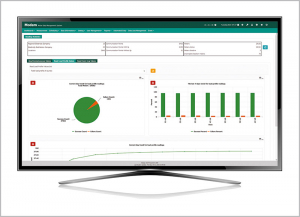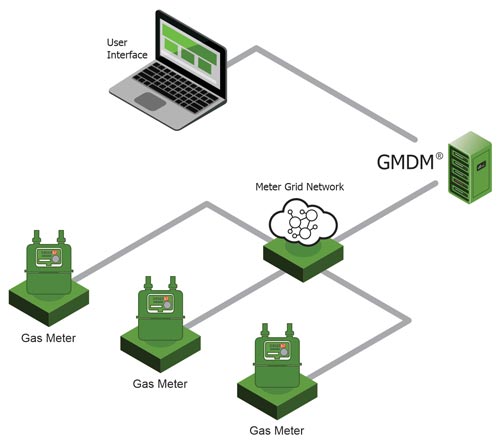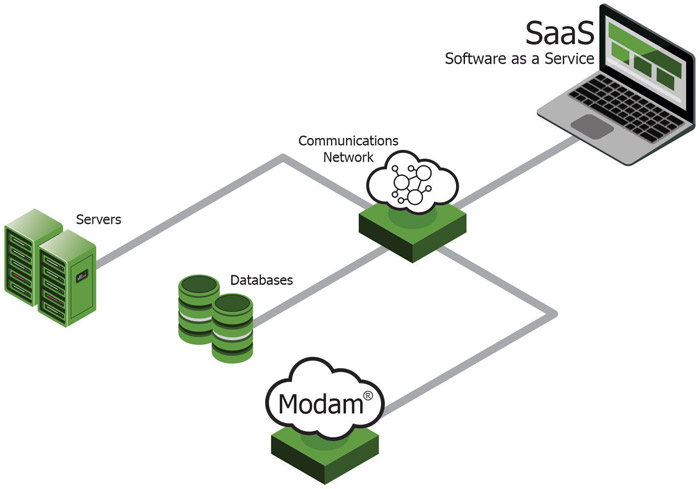Gas Meter Data Management Software (GMDM)
Modam
Overview
Gas Meter Data Management Software (Modam) is a Modular Platform capable of meter data collection and offers new possibilities for the utility sector with solutions for energy suppliers, grid operators, metering companies, energy service providers to offer innovative and attractive services. Modam platform provides useful and practical results and insights, helping all utility sector companies do better performance growing and optimizing the grid network.
Modam encompasses a portfolio of field-tested, analyzing large amount of data and revealing patterns, trends and complex reports combined with a results-driven deployment approach delivers greater business insights with less risk than other alternatives.
Benefiting from a very powerful engine, Modam provides a Fast, Reliable and Stable collection for utility companies that demand accurate and on-time data. The Intuitive user interface reduces the costs of user education resulting in lesser employee preparation period.
Advantages
- Fast and reliable collection of data from installed gas meters
- Complete and accurate VEE analytics and computation for the meter data
- Intuitive user interface, reducing training and operating costs
- SaaS, cloud concepts or non-site installations enable implementations seamless scaling from small pilots to large scale roll-outs
- Modular design principle and the Modam Modules ensure easy adaptation to new requirements and your own business goals
Benefiting from MDM system
Gas Meter Data Management Software (GMDM) system provides many benefits beyond just delivering advanced metering data. Data provided by the MDM systems can be used to improve system operations throughout the business. The MDM solution is the key unlocking the full potential of the energy network grid.
Making Utilities Smarter
Having a smart network that collects volumes of data from residential and commercial gas meters, utilizing a robust data management solution is essential for the utility sector. Providing secure, accurate and reliable data, Modam delivers operational efficiency that defines new frontiers to the business value.
Systems that operate with multiple isolated systems and databases, are prone to great bottlenecks, data losses and IT problems which lead to unoptimized resources, increasing staff and management costs thus reducing the efficiency of the whole system. Making the whole system as one integrated smart, fast, reliable and optimized smart network reduces the costs of field service, transferring data, providing real-time data needed for managing and growing the grid infrastructure to whole utility sector and customers.
Improving grid reliability, operations and customer satisfaction means collecting, validating, analyzing and acting on quality smart device data securely maintained in your data management system. To make these business activities function seamlessly, utilities rely on a data management system. Data management systems provide an ideal remedy that creates a system of record where consistent, secure and auditable processes are enforced, and where all users and external systems can access accurate and reliable data from smart meters.
Reliable Collection
The most important part of an MDM system is the data and more important the reliability of it. Reliability means data being accurately read from meters in predefined schedules without any system faults using powerful engine, resulting in regular, valid flow of data used to monitor, manage and develop the gas grid providing operational efficiency and revolutionizing business value.
VEE Analytics
In monitoring and reading meter data, there are times that faults in the grid network or meter itself can cause missing data or wrong data. In these cases Modam has validation and estimation scenarios that are implemented in the engine and are customizable in many options by the customers, that depending on the configuration, it intelligently recognizes the false or missing value, calculates and replaces the data.
Validation rules help recognize the meter faults resulting into invalid data such as value in the future, data being lower or greater than average, data being lower or greater than a defined value per meter, negative consumption, value in the future and etc.
Estimation rules help fill missing or invalid data according to the configured values. Missing data can be caused by power outages and meter malfunction. Invalid data on the other hand, can be caused by many situations including meter malfunction in tariffs, load profiles, date and time errors that can cause value in the past or future by the configured interval, faults in defined ratios and etc.
VEE also can help identify faults in the network and meters, resulting in great missing values reduction and providing reliable data to the customers.
Intuitive user interface
The operation education costs are of highest resource wastes that many companies endure. Also operating with multiple isolated systems and databases increases the education costs of employees and more than that, the rate of human errors leading to not reliable data thus reducing the business value. This normally increase when migrating to a new system.
Having an intuitive user interface that is designed by years of experience in the field and study over user experiences, reduces the costs of education by a great measure. An intuitive user interface provides a user friendly environment that user performs all business related processes without need to be educated. The only education needed for the employees will be the business itself.
Non-site installations
Having a comprehensive software also generates the need for a set of servers to be installed and maintained on. There are customers with certain degree of security guidelines which are obligated to purchase and maintain a local datacenter and install the MDM software on that configuration. On the other hand there customers which do not wish to purchase and setup such costly datacenters. There are many reasons that convinces customers not to setup a datacenter locally, such as setup and maintenance costs, limited number of metering points, no hardware upgrade needed when number of metering points grow, workplace availability over the internet making it possible to work from anywhere, not needing to upgrade to newer versions provided by developer, and etc.
Modam is designed to be installed both on-site and non-site, providing customers with variety of choices in utilizing it to their benefit, as it diverts the implementation costs towards business growth.
Modular Design
Designing and developing a software in modular structure is crucial for large-scale software systems. It reduces support and development time, enabling software developing companies to provide better and efficient solutions faster, providing customers the service, they need in much shorter time resulting in business value growth. This structure also enables rare bugs to be fixed just by altering a certain part of the software. This also makes changes and upgrades much more reliable for customers as there are many bad structured software which by each upgrade cause many problems for users, thus reducing productivity and causing great financial losses. Modam utilizes modular design principles which makes it a reliable, fast and powerful software made to provide benefit and business value to the customers. Modam MDM consists of various modules as follows.
Available modules:
- Collection Core
- Customer Service
- Customer Management
- Billing
- Work Order Management
- Report Builder
These modules are independent thus they benefit from each other’s data and structure fast and smooth. Other features requested by our customers can be implemented in the form of a module that provide the very best solution available to the customers.
1- Collection Core Module
Collection Core is a powerful engine based on advanced architecture that does the core scheduling, collection and estimation of consumption data from metering equipment (e.g., energy meters) and has the capability to configure meters.
This module has the ability to manage energy grid, the collected data and provide various and practical reports. Collection Core Module is also modularly designed and implemented, and consists of three sub-modules:
- Energy Grid Management
- Operation and Scheduling System
- Communication Drivers for collection and configuration of metering equipment
In the Energy Grid Management Module, utility managers can define, monitor and moderate grid production and consumption. Modam provides of all grid physical and virtual equipment, grid elements and reference meters with all related attributes from communication details to business characteristics for each node in the grid management sub-module. Modam is capable of managing virtual equipment, sensors, meters and DMAs, enabling utility managers to manage production, consumption and waste or leakage efficiently. This Module enables calculation of waste and leakage between reference and sub-meters in the energy grid.
With Scheduling and Operation System Module, all system operations can be set and scheduled e.g., equipment data collection and configuration, estimation, VEE, virtual meter calculations and etc.
Collection and configurations for each metering equipment is handled using communication drivers which can be deployed separately providing customers with choice to have only means to communicate with their installed or intended metering equipment model and also dynamically define which of the parameters they want to collect or configure. This will result in much lesser and efficient purchase and also if more meter model collection or configuration feature is requested by customer, then only the new driver will be added to the system without disrupting any other driver functionality.
There are cases in which customers collect meter data using another HES software or data is collected using hand-held devices. In these situations, customers will only get this module without communications driver sub-module, enabling them to collect data from external APIs into Modam MDM system.
2- Customer Service Module
Customer service is one of the Modam platform modules that encompasses all customer processes that deal with utility companies (e.g., customer registration, new branch request, meter replacement, meter relocation, ownership change, meter inspection and testing, general billing, etc.) thus speeding the processes and easing legal customer matters management. This module also manages the financial issues of the customers by keeping track of the depts and credits.
Customer service module provides cartable and workflow system that provide employees and specialists easy means to check and act on tasks assigned to them. Modam benefits from powerful workflow BPMN engine which enables developing all customer needed workflows and can provide modular workflow management and development.
Other than customer related workflows which in many cases are routine in all utility companies, all other internal workflows and even custom flows which are conducted in utility companies can be easily implemented in Modam and used. This enables utility companies to have all their work routines all in one solution, reducing many maintenance costs.
3- Customer Management Module
Customer management module as a part of Customer Service Module, is responsible for storage and management of all customer information. The management of reference and sub-meters, customer power outages and central cross business management of metering equipment (e.g., electric, gas and water meters).
All collected consumption data is transferred to customer management module and this data is used to provide comprehensive and practical operations and reports.
All customers can be continuously monitored via geographical map that is designed to provide insights on consumption status of the customers and generate different alarms on incidents collected from meters and sensors. This feature also enables utility companies to see the visualized energy grid and eases network management and development.
The customer map shows all registered customers and their reference meters and sub-meters and enables consumption calculation based on selected area on map. The geographical customers map is designed to work without internet and utilizes latitude/longitude and UTM coordination system, and also satellite and street views are usable.
4- Billing Module
Billing is one of the Modam platform modules that is responsible for calculating and issuing customer consumption bills and related practical reports. This module uses all financial and consumption data of customers from customer service systems and issues bills according to standard calculation and tariffication rules and formulas. Standards for bill calculations may differ in various countries, based on the country or utility rates policies. Modam’s billing module enables dynamic formula management for utility managers, enabling them to easily define, edit and use billing formulas for different types of customers.
The reports designed and implemented in this module provide comprehensive and practical information on all billing data of customers, enabling utility companies to manage consumption and the income according to energy production.
5- Work Order Management Module
Energy grids need constant and scheduled maintenance to keep the consumption measurement accurate and customers satisfied. As long as the energy grid is monitored, inspected and kept efficient, utility companies will not have to tolerate tremendous costs related to inaccurate measurements, meter hardware faults, grid faults and can reduce them to a meaningful and rational minimum.
Modam provides an environment to create, manage and monitor work orders for regular and percase inspections for a single or group of meters. Utility managers can also manage the association of inspectors with handheld devices and with comprehensive reports, will be able to track the work order fulfilment. Inspectors will receive work orders on their handheld devices and will carry out the tasks and will send the results to the MDM system after completion.
*Attention: Target device applications must have work order capability and API for receiving and uploading work order data. If by any means this functionality is not available, then German Metering can deliver the application by request.
6- Report Builder Module
There are many reports that are generated as the business grows, and per utility company they are different as the scope of energy grid from hardware to whole topology is different. Therefore, having a dynamic report builder module provides utility manager best means to manage their energy grid efficiently.
Modam delivers a Report Builder Module consisting of custom report generation and dashboard creation features. Utility managers can define parameters and generate various charts based on their needs and business values.
Meter Data Management Benefits
- Reduced field service costs through remote connect and disconnect and on-demand read capabilities.
- Reducing the number of maintained systems between collection, billing, outage, engineering and work management systems by having a stand-alone comprehensive system.
- Increased quality of data by operating a single, central system, instead of separate and inconsistent systems.
- Reduced IT implementation and maintenance costs
- Improved data reliability with automated, valid data reading straight from the meter
- Reducing data losses through VEE implementations
- Reducing manual intervention for residential customers, leaning focus on your most demanding customers
- Improved security and accountability through consistent auditing and versioning of all data
How it Works
Meter Data Management (MDM) system consists of three parts and each part plays an essential role in preparing and providing accurate data to the business owner.
- Meter data Collection
- Data processing
- Reporting
1. Meter Data Collection
Gas grid is a network infrastructure designed to deliver gas from gas treatment to customers. Measuring the nodes of this network from its start points to its end points, provides plenty of benefits for the utility companies. Each node in the network grid contains some factors that are measured by devices as we call them “gas Meters”. These meters have limited amount of storage on them making it essential to collect the measured data using a tool and store in a database.
The collection of data from meters can be done manually by using a combination of an HHU device and an optical probe as a data bearer and the transferring the collected data to a database manually. It can also be collected remotely using a third-party MDM software using a type of communication network, thus transferring data directly on-demand from the meter to the database.
Using manual labor in collecting data has many disadvantages for the utility companies. Some of these disadvantages are mentioned below:
- Time-consuming activity
- Meter reader labor costs
- Dangers and incidents for meter readers
- Access to meters to read them
- Human errors causing invalid and unreliable data leading to costly decisions
- No on-demand data making incident management impossible
- Non-frequent data collection resulting in not plannable data
- Meter reader and customer collusion resulting in invalid data
- Several inconsistent systems resulting in high maintenance costs
Using an AMI solution with an MDM software not only solves the problems of manual reading, but also adds many beneficial features. Some of these features are mentioned below:
- Fast and frequent consumption information
- Small periods of data collection leading to highly detailed analysis of consumption data
- Reduced field service costs through remote connect and disconnect and on-demand read capabilities.
- Reducing the number of maintained systems between collection, billing, outage, engineering and work management systems by having a stand-alone comprehensive system.
- Increased quality of data by operating a single, central system, instead of separate and inconsistent systems
- Reduced IT implementation and maintenance costs
- Improved data reliability with automated, valid data reading straight from the meter
- Reducing data losses through VEE implementations
- Reducing manual intervention for residential customers, leaning focus on your most demanding customers
- Improved security and accountability through consistent auditing and versioning of all data
2. Data Processing
Data collected from meters must be validated, cleansed and processed they can be used in billing and analysis. These processes are called VEE analytics. VEE analytics consist of validation, editing, and estimation of data collected from meters.
In monitoring and reading meter data, there are times that faults in the grid network or meter itself can cause missing data or wrong data. In these cases there are validation and estimation scenarios that are implemented in the MDM engine and are customizable in many options by the customers, that depending on the configuration, it intelligently recognizes the false or missing value, calculates and replaces the data.
Validation rules help recognize the meter faults resulting into invalid data such as value in the future, data being lower or greater than average, data being lower or greater than a defined value per meter, negative consumption, value in the future and etc. Identifying these faults in time, can help prevent more data losses by alerting the utility operators in time so they can deploy repair teams on-site to fix the occurred problem at the specific node in grid.
Estimation rules help fill missing or invalid data according to the configured values. Missing data can be caused by power outages and meter malfunction. Invalid data on the other hand, can be caused by many situations including meter malfunction in tariffs, load profiles, date and time errors that can cause value in the past or future by the configured interval, faults in defined ratios and etc.
VEE also can help identify faults in the network and meters, resulting in great missing values reduction and providing reliable data to the customers.
3. Reporting
The first duty of an MDM software is to collect and process the data from meters and give them meaning through various reports implemented in it. The accuracy of these reports rely only on the meter data accuracy. Having practical and useful reports, will result in grid management efficiency.
Reports can be thoroughly customized depending on the country, grid technology or energy policies.
Technical Specifications
- System architecture: Layered with logical subsystems, and SOA based
- Implementation platform: Web Base, Browser and device Independent
- Database: RDBMS with SQL Server 2019
- Communication with other related systems: SOAP with WCF
- Framework: .Net Framework 4.5
- Programming language: C#
Applications
Modam platform has the ability to communicate, collect, send and receive information of various types of equipment such as smart meters (electricity, water and gas), remote reading modems, sensors, measuring equipment, instrumentation, etc. It can be used in various businesses such as:
- Electricity generation and distribution companies
- Water production and distribution companies
- Gas production and distribution companies
- Petrochemicals
- Refineries
- Airports
- Industrial estates
- Business centers
- Passages
- Residential complexes









